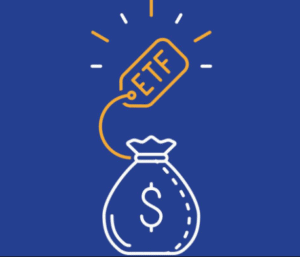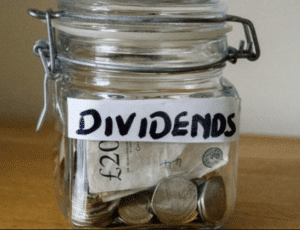What is an ETF? Learn the Meaning & How to Invest in ETF Funds
While most newbie investors decide to buy shares in individual companies, it might be worth exploring stock ETFs. In doing so, you will be investing in dozens, if not hundreds of companies through a single trade.
Not only does this allow you to diversify at the click of a button, but it’s also ideal if you do not know which specific companies to buy shares in. Best of all, you will still be entitled to dividends if and when they are paid!
In this guide, we explain what ETFs are, how they work, who they are suitable for, and what you need to do to make an investment today.
-
-
What are ETFs? ETF Meaning and Definition
 Let’s start with the basics – what are ETFs? Exchange-Traded Funds, or simply ‘ETFs’, allow you to invest in a basket of assets through a single trade. In the case of stocks and shares, an ETF investment will consist of dozens (sometimes hundreds) of companies.
Let’s start with the basics – what are ETFs? Exchange-Traded Funds, or simply ‘ETFs’, allow you to invest in a basket of assets through a single trade. In the case of stocks and shares, an ETF investment will consist of dozens (sometimes hundreds) of companies.This is ideal for a number of reasons – such as being able to diversify your portfolio at the click of a button. ETFs are also suitable if you want to gain exposure to the stock markets, but you don’t know which firms to invest in.
A prime example of a stock market ETF that is popular with UK investors is that of the iShares Core FTSE 100 UCITS ETF. The ETF – which is backed and managed by iShares, invests in the 100 companies that make up the FTSE 100. This will include the likes of BP, Tesco, HSBC, British American Tobacco, and GlaxoSmithKline.
In another example, the SPDR S&P 500 ETF is also popular with UK investors that are looking to buy international shares. The ETF in question will purchase stocks in 500 large companies that are listed in the US. This will include everything from Facebook, IBM, Apple, Microsoft, Disney, Nike, and Ford Motors. Ultimately, this allows you to buy shares in heaps of different firms without needing to worry about technical analysis, earnings reports, or any other highly advanced stock terminology!
How do ETFs Work?
From your perspective, investing in an ETF is just as easy as buying shares in the traditional way, With that said, it is important that you at least have a basic understanding of how ETFs work before you get started. That way, you can assess whether not this particular investment stream is right for you.
- So, let’s assume that you are looking to gain exposure to UK stocks. As such, you opt for an ETF that targets the FTSE 100 – which is an index that tracks the 100 largest public companies in the UK.
- The respective ETF provider (there are many) will then personally purchase shares in the 100 companies. They will do so at an amount appropriate to the index. For example, if Tesco makes up 1.5% of the FTSE 100, the ETF will hold 1.5% of shares in Tesco. Similarly, if Barclays makes up 2.5%, the ETF will ensure that 2.5% of the portfolio is in Barclays shares.
- Once you invest in the ETF, you will indirectly own a percentage of the basket of 100 shares. Sticking with the same example as above, 1.5% of your portfolio would be held in Tesco, 2.5% in Barclays, and the remained elsewhere.
- As such, had you invested £10,000 into the ETF, you would own £150 worth of shares in Tesco, £250 in Barclays, and so on.
Ultimately, the amount that you invest in an ETF is diversified across the entire basket. Crucially, this allows you to buy a significant amount of different shares through a single investment.
What are the Advantages of Investing in Stock ETFs?
There are many advantages of investing in a stock ETF – especially if you are a beginner.
This includes:
No Need to Pick Stocks on a DIY Basis
One of the biggest barriers facing newbie stock investors is that of selecting companies. This is especially the case when you use an online stock broker that gives you access to thousands of shares.
What often happens is that inexperienced investors choose a company because they like its products or services, or they simply have a ‘hunch’ that it might do well.
At the other end of the spectrum, experienced investors will spend considerable amounts of time researching a company before buying its shares. They will look at everything from the balance sheet, earnings reports, fundamental and technical analysis, and more.
With that being said, buying shares through an ETF takes all of these challenges away. This is because the ETF provider will buy and sell shares on your behalf. For example, if you want to gain exposure to technology stocks, the ETF will buy specific shares based on a set criteria. Similarly, if you want to invest in US stocks, the ETF might target the Dow Jones 30 or S&P 500.
Read More: If you do want some pointers on how to pick stocks to invest in, check out our beginner’s guide.
Instantly Diversify Your Share Investments
Irrespective of your experience in the investment scene, ETFs are ideal for diversification purposes. For those unaware, diversifying simply means that you invest in lots of different companies from several sectors – to ensure you do not overexpose yourself to a small number of firms.
As ETFs typically hold dozens (and sometimes hundreds) of companies within its portfolio, you can diversify at the click of a button. For example, let’s suppose that you want to invest in UK companies, but at the same time, diversify as best as you can. By investing in the SPDR FTSE UK All Share ETF, you are effectively buying shares in over 600 UK firms.
Cost-Effective and Easy
If you were to create a diversified portfolio of shares on a DIY basis – you would end up paying a significant amount of money in brokerage fees. For example, the likes of Hargreaves Lansdown charges an entry rate of £11.95 per trade. In Layman’s terms, this means that every time you buy a share, you will need to pay £11.95. You will pay this fee again when you sell your shares.
- So, if you were to diversify across 50 different companies, this would cost you a staggering £597.5 in share dealing charges (£11.95 x 50 trades).
- In comparison, when you invest in an ETF, you are placing one trade, and one trade only. As such, you can invest in dozens of different stocks and pay just one share dealing charge!
You also need to consider the inconvenience of personally buying shares in 50 different company. Not only would the process be cumbersome and expensive, but extremely time-consuming. Once again, buying shares through an ETF requires just one trade – which can be completed in minutes.
Do Stocks and Share ETFs pay Dividends?
In the vast majority of cases, ETFs holding stocks and shares will distribute dividends to investors. These ETFs are known as ‘Distributed ETFs‘, and they ensure that investors receive dividends in the same way that they would have had they bought the shares individually.
It is important to note that you won’t get the dividends as soon as they are paid by the respective company – as this would be a logistical nightmare. For example, let’s suppose that you invested in an ETF that tracks the S&P 500. This means that you would indirectly hold shares in 500 companies – many of which are dividends stocks.
As companies distribute dividends at different dates throughout the year, it would be counter-productive for the ETF to forward these on day-in, day-out. Instead, ETFs will typically forward your dividend payments every three months. This will be paid to the brokerage firm that you used to invest in the ETF, and subsequently reflected in your account.
Let’s look at a quick example of how this would work in practice.
- You invest £10,000 into an ETF that tracks the FTSE 100 (remember, this is 100 large UK companies)
- In the first three months of making an investment, 59 companies have distributed dividends
- The ETF collects these dividends and holds them until the last day of the quarter
- The dividends amount to an annualized yield of 5%
- As such, £125 is paid into your brokerage account ([£10,000 x 5%] / 4)
Once the dividends are paid into your brokerage account, you can either reinvest them into other assets or withdraw them back to your bank account.
What About Capital Gains When I Invest in a Stock ETF?
As great as dividends are when investing in an ETF, you can also make money in the form of capital gains. This is where the value of the shares held in the ETF’s portfolio increase in value. If they do, you will benefit.
However, it’s a bit more complicated when you invest in shares through an ETF, as you do not have direct control over the stocks. Instead, the ETF provider dictates which shares are bought and sold, and when this should happen.
The good news is that ETFs are actually listed on public stock exchanges – meaning that you can easily realize your gains by exiting the position. Before we get to that, we need to examine how you make capital gains when investing in an ETF.
- Let’s suppose that you invest £5,000 in an ETF that tracks technology stocks
- The total NAV (Net Asset Value) of the ETF is £2 billion
- This is because when adding all of the shares held by the ETF provider together, it amounts to a value of £2 billion
- The shares held by the ETF are performing well, and so 12 months later the NAV is 20% higher
- As you invested £5,000 – your money is now worth 20% more, taking it to £6,000
So, although your ETF investment is worth 20% more than you originally paid, the only way that you can realize these gains is to sell the ETF. If you do, you will receive £6,000 – which will be added to your brokerage account balance. Crucially, this is no different from realizing your capital gains when buying shares individually, as you still need to sell them to get your hands on the profits!
Stock ETFs – Fees and Commissions
When you invest in the stocks and shares space, you will always need to pay a fee of some sort. In the case of ETFs, this typically comes in two forms.
- Dealing Charge: Much like you would when you buy shares on a DIY basis, brokers typically charge a share dealing fee when you invest in an ETF. This is usually a flat fee, so the size of your investment is irrelevant.
- Maintenance Fee: ETF providers typically charge an annual maintenance fee. This is to cover the costs of managing and facilitating the ETF on behalf of investors. The fee is a variable one, meaning it is calculated against the size of your investment. For example, if the maintenance fee amounts to 0.5% and you invest £1,000 – you will pay £5 per year. If using a broker to invest in an ETF, the fee is normally taken from your account balance.
How do I Invest in Stock ETFs?
So now that you know the ins and outs of how stock ETFs work, we now need to discuss the actual investment process.
Step 1: Choose a UK Broker That Offers ETFs
Your first port of call will be to choose a UK broker that offers ETFs. If you’re from the UK, the good news is that you will have hundreds of platforms to choose from. With that said, not all platforms are worthy of your business.
Below are some of the questions that you should be asking of an ETF broker before you sign up.
- Is the broker regulated by the Financial Conduct Authority (FCA)?
- Does the broker list the specific stock ETF that you wish to invest in?
- If so, how much does the broker charge in fees, commissions, and annual maintenance?
- Does the broker accept your preferred payment method – such as a UK debit/credit card or bank account?
- What is the minimum deposit and investment amount?
- Is the broker suited for newbie investors?
Finding a UK stock broker that meets your personal needs can be time-consuming, so we would suggest reading our beginner’s guide.
Step 2: Open an Account and Verify Your Identity
Once you have found a UK stock broker that you like the look of, you will then need to open an account. Most providers allow you to do this in a matter of minutes via your desktop computer or mobile phone.
Either way, you will need to provide the following information:
- Full Name
- Home Address
- Date of Birth
- National Insurance Number
- Contact Details
As you will be using an FCA-regulated broker, you will also need to verify your identity. Some brokers will attempt to do this automatically by matching your information with third-party sources. Others will ask you to quickly upload a copy of your passport or driver’s license.
Step 3: Deposit Funds
When you invest in stock ETFs online, you will first need to add funds to your brokerage account. Most platforms will have a minimum deposit threshold that you need to meet – which typically sits within the £100-£250 range.
In terms of supported payment methods, this will also vary from broker-to-broker.
Your options might include a:
- Debit Card
- Credit Card
- E-Wallet
- Bank Account
Be sure to check whether or not your chosen broker charges any deposit fees.
Step 4: Invest in a Stock ETF
As soon as your account has been funded, you can proceed to invest in an ETF.
So, you will first need to search for the stock ETF that you wish to invest in. In our example, we want to invest in the Vanguard FTSE All-Shares, so we enter this into the search box and then click on ‘Trade’.
We will then be shown an ‘order box’. Although this might look somewhat intimidating, the process is actually very simple. All you need to do is enter the amount that you wish to invest, and confirm the order. We are looking to meet the minimum, which is $50.
And that’s it – you’ve just invested in a stock ETF on a commission-free basis!
Conclusion
In summary, ETFs are a great alternative to buying shares on a DIY basis. In fact, they are highly conducive if you are investing in stocks and shares for the first time and you are unsure which companies to select. Stock ETFs are also great for diversification purposes, as you can invest in dozens of different shares through a single investment. With that said, always consider the risks of investing your hard-earned money – as the stock markets offer no guarantees!
FAQs
What is an ETF?
An ETF (Exchange-Traded Fund) allows you to invest in a group of companies through a single trade.
How do I make money from a stock ETF?
You will make money the very same way that you would do if buying shares individually. That is to say, you stand the chance of growing your investment through capital gains and/or dividends.
How are ETFs traded?
In the vast majority of cases, ETFs are listed on public stock exchanges like the London Stock Exchange. As such, the value of the ETF will go up and down - based on the performance of the stocks it holds.
Do ETFs pay dividends?
As long as you are investing in a distributed ETF, you will be entitled to your share of dividends. Your dividends will typically be distributed by the ETF provider every three months.
What is the best UK ETF?
There is no such thing as a 'best' UK ETF as it all depends on personal preference. With that said, if you want to gain exposure to a broad number of UK companies, it might be worth looking at Vanguard FTSE All-Shares ETF - which covers 600 UK companies from various sectors.
Kane Pepi
View all posts by Kane PepiKane Pepi is a British researcher and writer that specializes in finance, financial crime, and blockchain technology. Now based in Malta, Kane writes for a number of platforms in the online domain. In particular, Kane is skilled at explaining complex financial subjects in a user-friendly manner. Academically, Kane holds a Bachelor’s Degree in Finance, a Master’s Degree in Financial Crime, and he is currently engaged in a Doctorate Degree researching the money laundering threats of the blockchain economy. Kane is also behind peer-reviewed publications - which includes an in-depth study into the relationship between money laundering and UK bookmakers. You will also find Kane’s material at websites such as MoneyCheck, the Motley Fool, InsideBitcoins, Blockonomi, Learnbonds, and the Malta Association of Compliance Officers.
WARNING: The content on this site should not be considered investment advice and we are not authorised to provide investment advice. Nothing on this website is an endorsement or recommendation of a particular trading strategy or investment decision. The information on this website is general in nature, so you must consider the information in light of your objectives, financial situation and needs. Investing is speculative. When investing your capital is at risk. This site is not intended for use in jurisdictions in which the trading or investments described are prohibited and should only be used by such persons and in such ways as are legally permitted. Your investment may not qualify for investor protection in your country or state of residence, so please conduct your own due diligence or obtain advice where necessary. This website is free for you to use but we may receive a commission from the companies we feature on this site.
Buyshares.co.uk provides top quality insights through financial educational guides and video tutorials on how to buy shares and invest in stocks. We compare the top providers along with in-depth insights on their product offerings too. We do not advise or recommend any provider but are here to allow our reader to make informed decisions and proceed at their own responsibility. Contracts for Difference (“CFDs”) are leveraged products and carry a significant risk of loss to your capital. Please ensure you fully understand the risks and seek independent advice. By continuing to use this website you agree to our privacy policy.
Trading is risky and you might lose part, or all your capital invested. Information provided is for informational and educational purposes only and does not represent any type of financial advice and/or investment recommendation.
Crypto promotions on this site do not comply with the UK Financial Promotions Regime and is not intended for UK consumers.
BuyShares.co.uk © 2026 All Rights Reserved. UK Company No. 11705811.
We use cookies to ensure that we give you the best experience on our website. If you continue to use this site we will assume that you are happy with it.Scroll Up
 One of the biggest barriers facing newbie stock investors is that of selecting companies. This is especially the case when you use an online stock broker that gives you access to thousands of shares.
One of the biggest barriers facing newbie stock investors is that of selecting companies. This is especially the case when you use an online stock broker that gives you access to thousands of shares. In the vast majority of cases, ETFs holding stocks and shares will distribute dividends to investors. These ETFs are known as ‘
In the vast majority of cases, ETFs holding stocks and shares will distribute dividends to investors. These ETFs are known as ‘